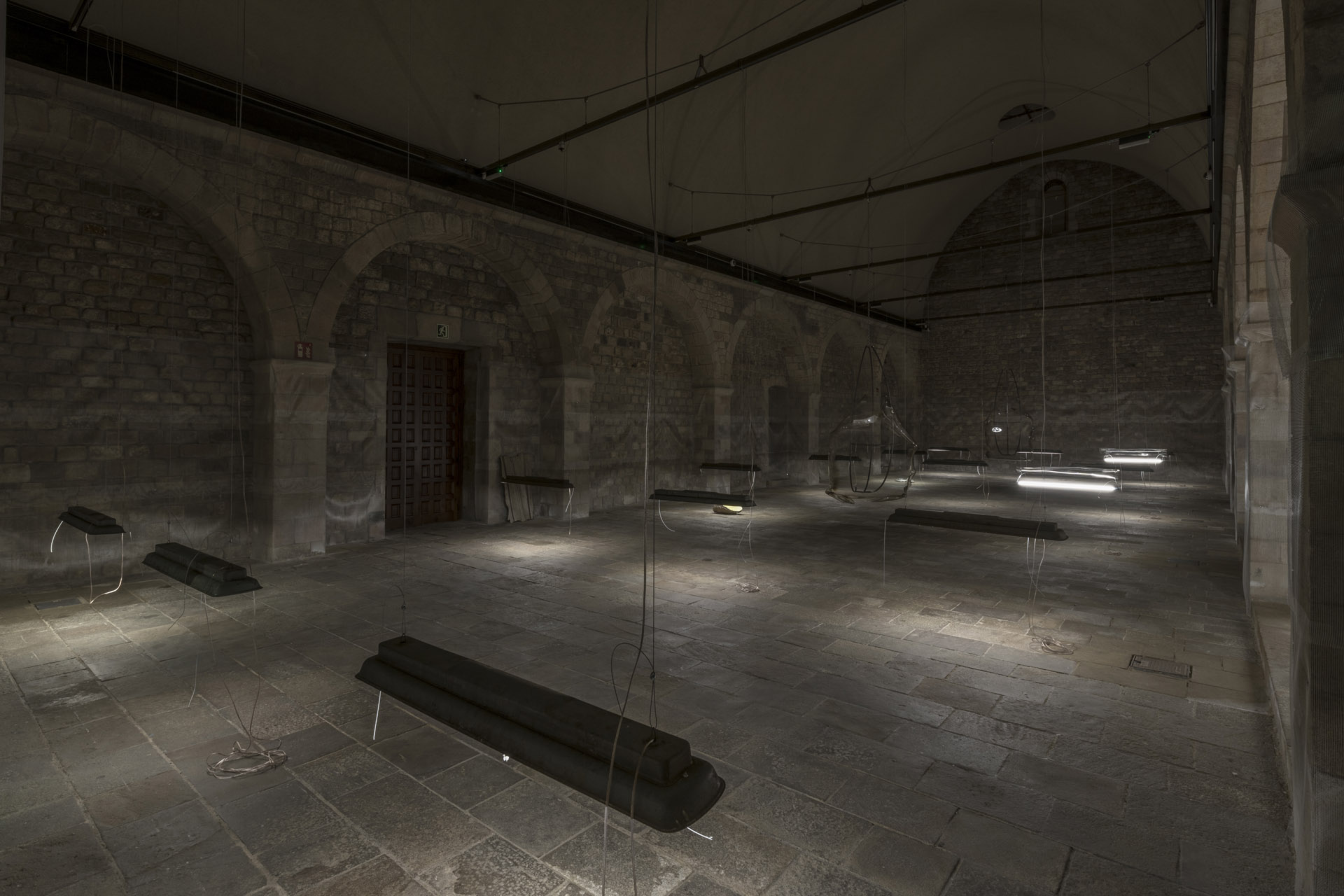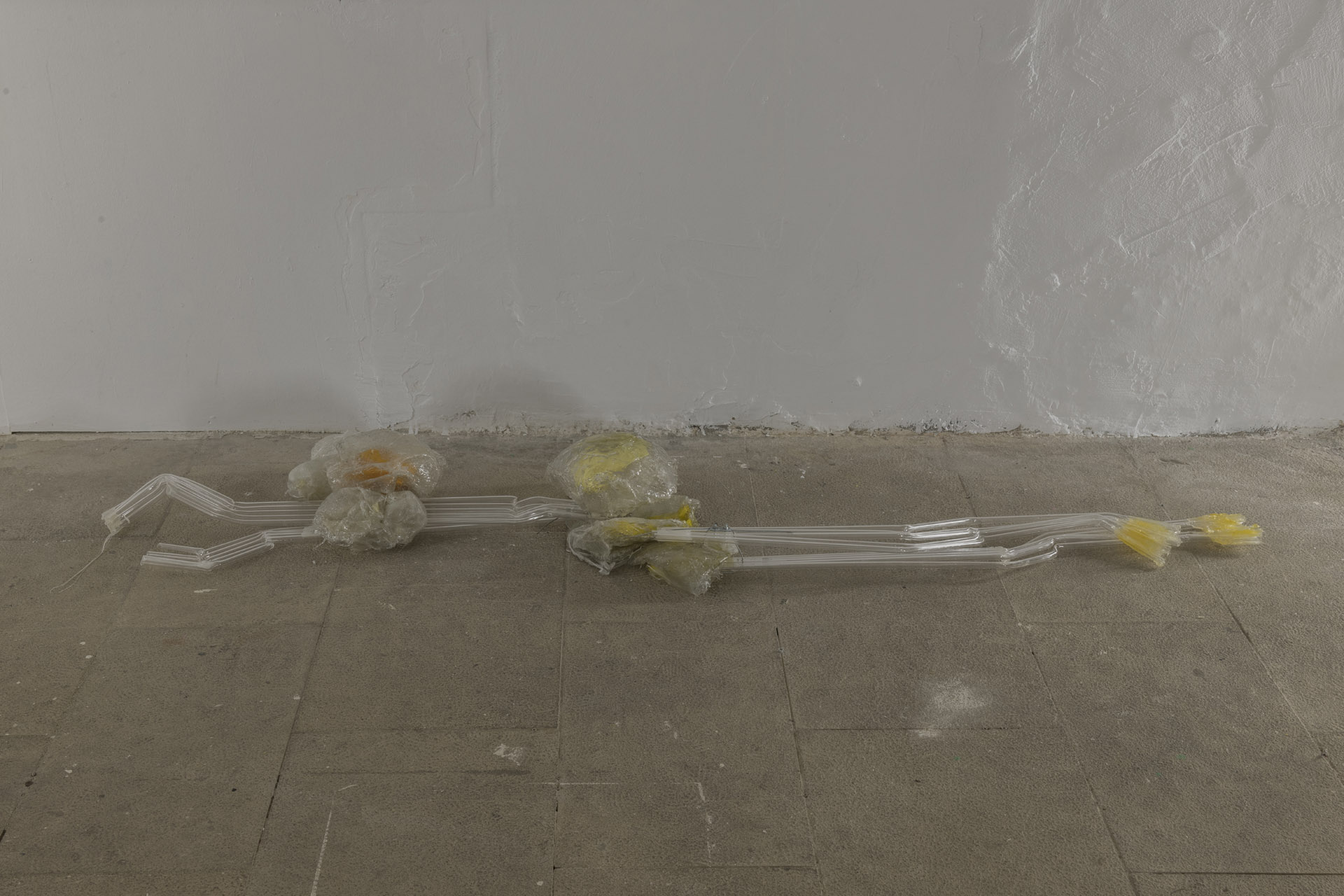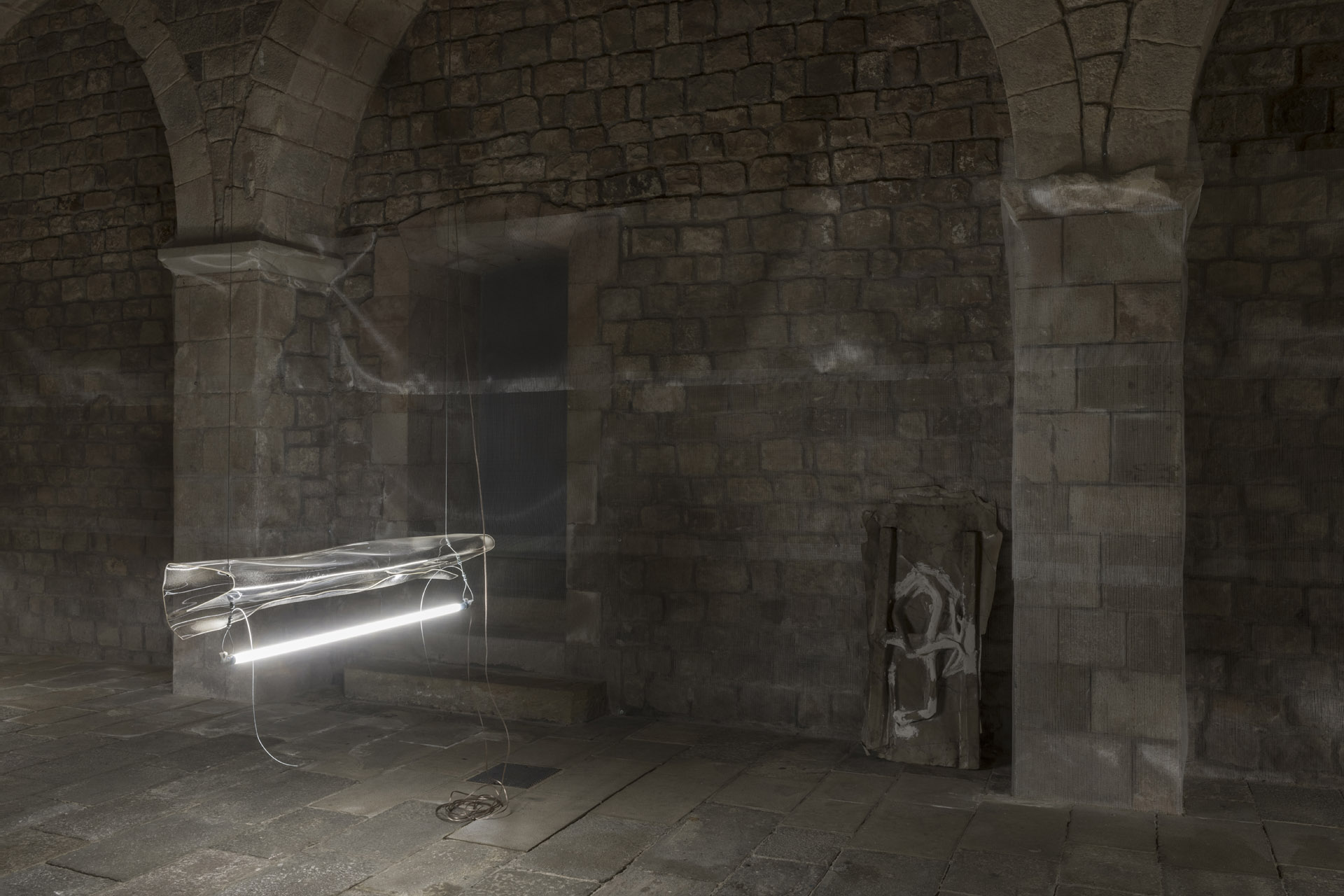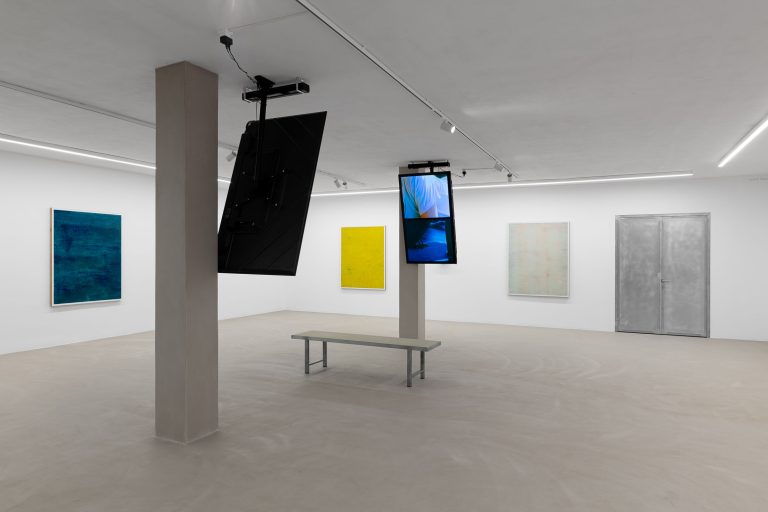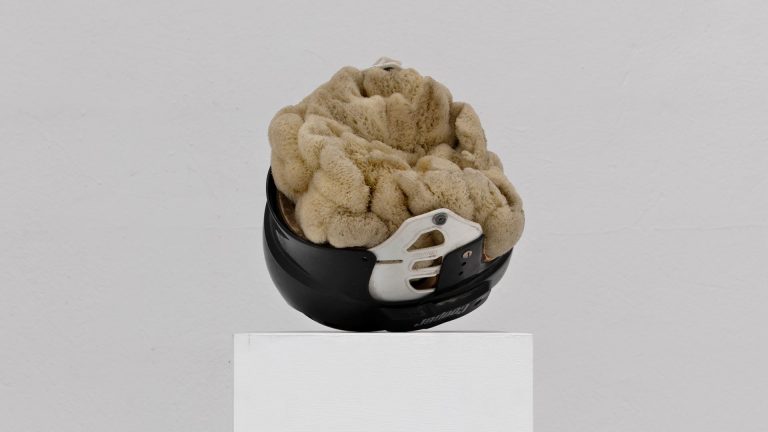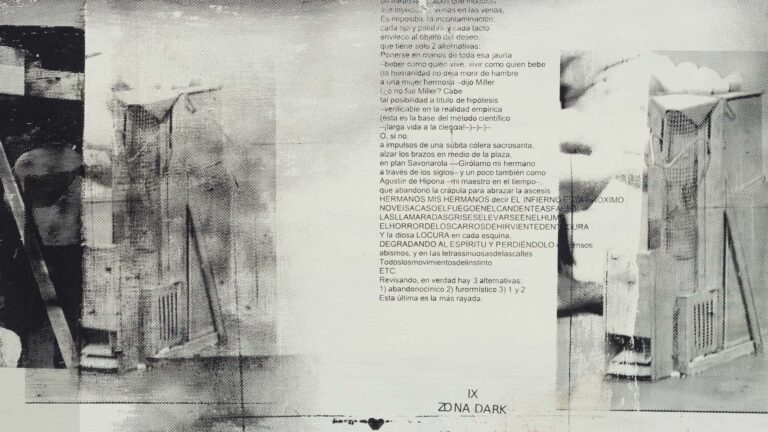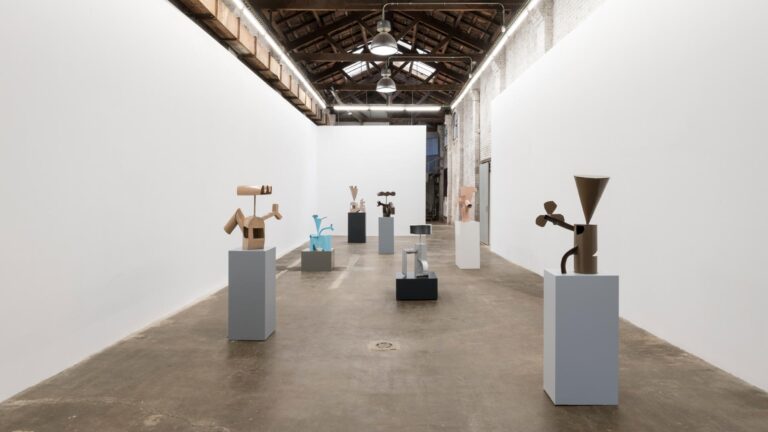Artist: Lucía C. Pino
Exhibition title: Makebelieve Neuromancer
Venue: La Capella, Barcelona, Spain
Date: February 23 – May 30, 2021
Photography: Roberto Ruiz / all images copyright and courtesy of the artist and La Capella, Barcelona
vest armour coming to rest be brown
light as you lie against me
I will be heavy as August over your hair Our rivers will go to the same sea We will leave full of amazement and illuminations dealt through the short tongues
I Makebelieve Neuromancer is an immersive sculpture installation that explores the idea of transience and its ability to form other modes of existence and subjectivity.
Lucía C. Pino’s research in materials and their qualities, their assemblages and agency is based on our intriguing relationship with them. She explores the behaviour of resins, iron, synthetic or biological plastics, fibreglass, binders, etc. by deconstructing and testing various assemblages, thereby expanding the common ways of relating between these and their potential for change and contingency.
The installation reflects the artist’s explorations of states of matter and the crystallisation of viscosity. Her goal is that brief moment when the material is pure power, just when it acquires a malleability and fluidity that forever alters its form and composition. Even though it retains the hardness and memory of what it was, the material assumes the imprint of its transformation process and becomes an archaeology of the present still pointing to the past, while at the same time outlining future possibilities. This memory is also maintained in recovered, reused materials that have been used for other purposes and retain the memory of their own journey.
The elements comprising Makebelieve Neuromancer and the bonds between them appeal to transience, to having been something else and becoming something different. The sculpture pieces, their components and gestures of intervention in the space, all these elements insist on hybridising their intrinsic qualities, on responding by coming into contact with other molecules, on structural transgression.
The solid sections confront light volumes that recall the idea of a skeleton with its protective armour, taking the concept of prophylaxis that formally surrounds the pieces even further. The sculpture is an integument overlaid over a frame, light as you lie against me, heavy as August over your hair. A covering that recreates large non-canonical bodies, fragile and vulnerable bodies that multiple biopolitical crises strive to awaken.
The body, like all other materials, has its own agency and capacity for transformation. This potential for mutation is encouraging and hopeful and converts the exhibition space into a Heraclitean place, a panta rei whose only constant is change, celebrating continuous positive becoming.
One senses a tension between the concept of the double and the transit condition of its components in the installation. The double, the pair, the binary is in tension with all that is hybrid in between, creating a mutant place whose coordinates are not yet fully drawn. That place where one lacks the feeling of having arrived but of always going, and yet this does not imply any failure. That celebrates transience as a habitable place and not simply as a place of passage.
Insisting on the transitory questions the subjectivity that flows and slips away from stringent terminologies and normative, castrating definitions. It recognises and pays tribute to those who choose to live this transformation and position their bodies at the centre of situations that urgently need to be debated and changed.
The title, Makebelieve Neuromancer, is a play on paired words based on two transgressive fictions from the late 20th century, cult works in the queer world: Stone Butch Blues by Leslie Feinberg and one of the stories from the book Chelsea Girls by Eileen Myles, which takes us on a hallucinatory journey through the gay bars of New York in the 1990s. The fiction of bodies as living sculpture across the city is recreated (in the sense that it is reproduced and rejoiced) in the fiction of the exhibition space, with the imagery and semiotics of a formerly religious space.
The lines that follow the title are a linguistic twist of one of the poems from The Black Unicorn by Audre Lorde. This twist to which the artist subjects the word becomes an added material to her work and leads to questioning what things are supposed to be, firstly because, as has already been mentioned, everything is in constant change, and secondly, because if the materials that we have are of no use to us, then why not modify them?
The installation Makebelieve Neuromancer recalls the way in which the artist understands sculptural practice, as a poetic becoming and a way of approaching knowledge that goes beyond binary and logocentric discursive immobilism, a way of introducing re-enchantment and re-signification in certain stories without intending to illustrate them. And furthermore, it offers an optimistic- queer confrontation that serves to discuss the anthropo(andro)centric extractivist hegemony that has mired us in the dystopian swamps of a planetary duel.
-Pilar Cruz
The work of Lucía C. Pino revolves around research focused on materiality and its contingency, creating sculpture assemblages with a desire to explore the cracks of the dystopia in which we are immersed and what emerges from there as a resignifying power. All this by opting for a physical and environmental presence in search of possible re-enchantments.
Lucía C. Pino has shown her work in solo and group exhibitions held in centres such as Arco (2020 and 2019), Dilalica (2020), Et-hall (2020 and 2017), (2020 and 2017), COAC (2019 and 2016), Heinrich Ehrhardt Gallery (2018), Espai 13 in Fundació Joan Miró (2018), Espositivo (2018), Bólit (2018), Arts Santa Mònica (2017), FAD (2016), àngels barcelona (2016), Ana Mas Projects (2015), ADN Platform (2015), Local Project Art Space in New York (2013), Pragda Big Screen Project in New York (2011), Casa Àsia in Barcelona (2010), Milan Triennial (Italy, 2006) and D/ART in Sydney (Australia, 2006). She was recognised as the best Spanish artist of 2020 by DKV Swab, as well as having also received ArtsFAD recognition and an Osic grant in 2019. Her work can be found in the collections of MACBA, DKV Arteria, Utopicus Art and olorVISUAL of the Fundación Ernesto Ventós.
Lucía C. Pino, Anhelo I, metal, fluorescent, methacrylate, polyester resin, fiberglass, acer, silver, tensors. Size: Different elements assembled with different measures 126x123x95cm 157x110x30cm 60x52x9cm
Lucía C. Pino, Anhelo I, metal, fluorescent, methacrylate, polyester resin, fiberglass, acer, silver, tensors. Size: Different elements assembled with different measures 126x123x95cm 157x110x30cm 60x52x9cm
Lucía C. Pino, Anhelo I, metal, fluorescent, methacrylate, polyester resin, fiberglass, acer, silver, tensors. Size: Different elements assembled with different measures 126x123x95cm 157x110x30cm 60x52x9cm
Lucía C. Pino, Anhelo I, metal, fluorescent, methacrylate, polyester resin, fiberglass, acer, silver, tensors. Size: Different elements assembled with different measures 126x123x95cm 157x110x30cm 60x52x9cm
Lucía C. Pino, Eros, resin, fiberglass, silicon, metal, gesso, resin with cement, paraffin, 63x18x12 cm
Lucía C. Pino, Eros, resin, fiberglass, silicon, metal, gesso, resin with cement, paraffin, 63x18x12 cm
Lucía C. Pino, Eros, resin, fiberglass, silicon, metal, gesso, resin with cement, paraffin, 63x18x12 cm
Lucía C. Pino, Eros, resin, fiberglass, silicon, metal, gesso, resin with cement, paraffin, 63x18x12 cm
Lucía C. Pino, Sabiħa incredule, fiberglass, resin, latex, plaster, gesso, paraffin, pigment Size: 58x38x16 cm, Sabiħa incredule: the first word come from Maltese language, and means beauty. So would be something as the sceptical beauty, fiberglass, resin, cement, paraffin and pigment. Size: 58x38x16 cm
Lucía C. Pino, Sabiħa incredule, fiberglass, resin, latex, plaster, gesso, paraffin, pigment Size: 58x38x16 cm, Sabiħa incredule: the first word come from Maltese language, and means beauty. So would be something as the sceptical beauty, fiberglass, resin, cement, paraffin and pigment. Size: 58x38x16 cm
Lucía C. Pino, Makebelieve Neuromancer, 2021, exhibition view, La Capella, Barcelona
Lucía C. Pino, Makebelieve Neuromancer, 2021, exhibition view, La Capella, Barcelona
Lucía C. Pino, Makebelieve Neuromancer, 2021, exhibition view, La Capella, Barcelona
Lucía C. Pino, Rare Oroki, methacrylate, resin, fiberglass, plastic, silicon and pigment, Rare oroki comes from the idea of having a selfdefense weapon. This weapon, in my fantasy, could neutralise a possible predator, through a sound, a gas or a light, 215x50x15cm
Lucía C. Pino, Makebelieve Neuromancer, 2021, exhibition view, La Capella, Barcelona
Lucía C. Pino, Makebelieve Neuromancer, 2021, exhibition view, La Capella, Barcelona
Lucía C. Pino, Lamias, metal and methacrylate, 280x138x215cm, 251x125x165cm
Lucía C. Pino, Lamias, metal and methacrylate, 280x138x215cm, 251x125x165cm
Lucía C. Pino, Lamias, metal and methacrylate, 280x138x215cm, 251x125x165cm
Lucía C. Pino, Anhelo I, metal, fluorescent, methacrylate, polyester resin, fiberglass, acer, silver, tensors. Different elements assembled with different measures 126x123x95cm 157x110x30cm 60x52x9cm
Lucía C. Pino, performance by Roxman Gatt, 2021, La Capella, Barcelona
Lucía C. Pino, performance by Roxman Gatt, 2021, La Capella, Barcelona
Lucía C. Pino, performance by Roxman Gatt, 2021, La Capella, Barcelona
Lucía C. Pino, performance by Roxman Gatt, 2021, La Capella, Barcelona













